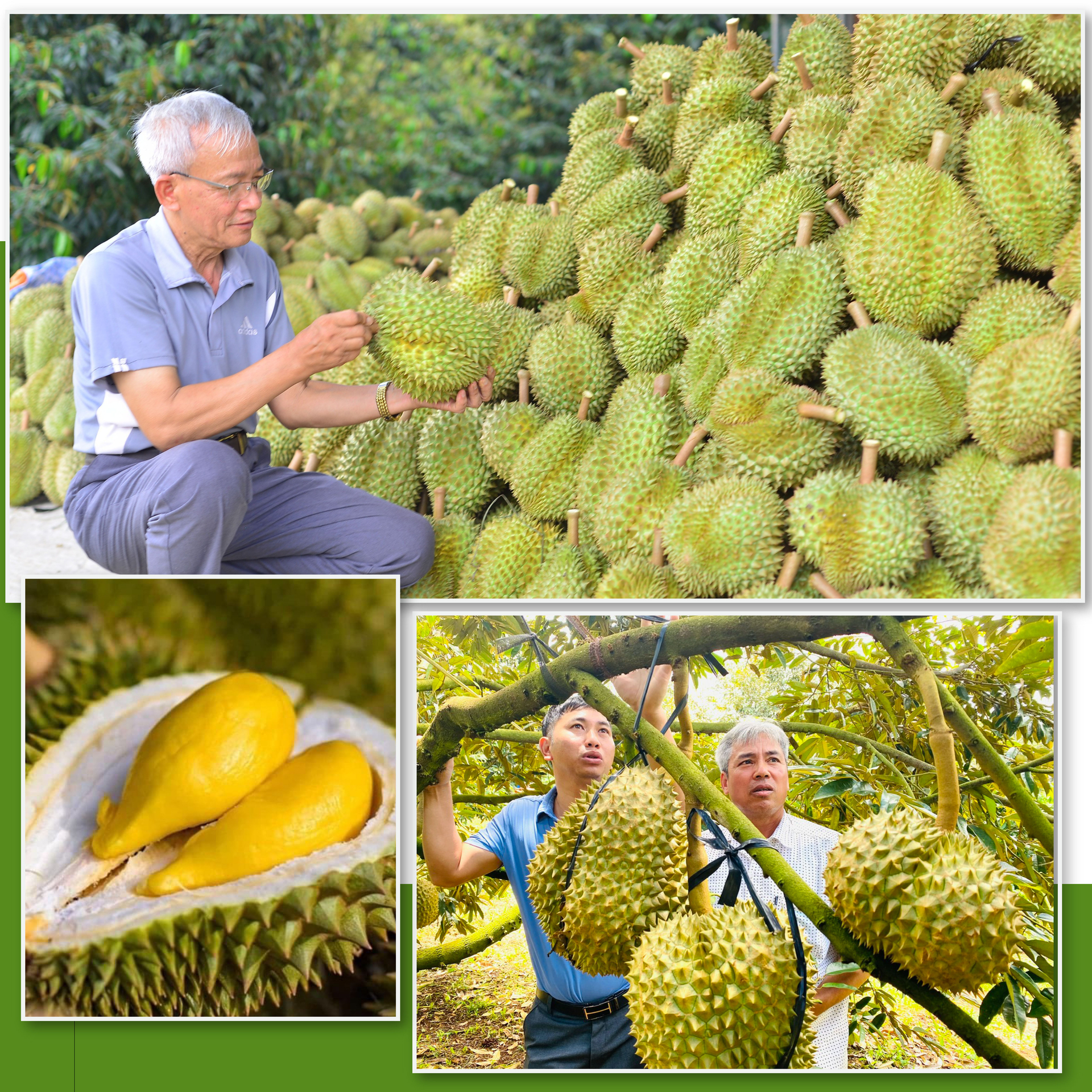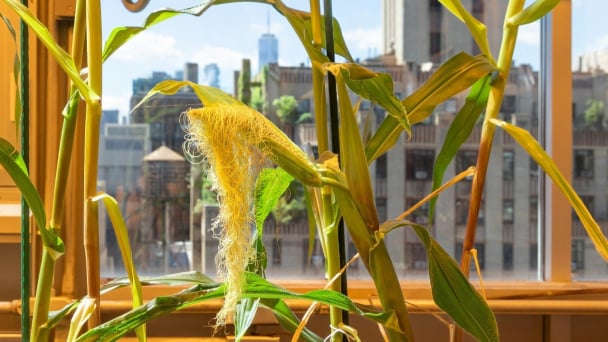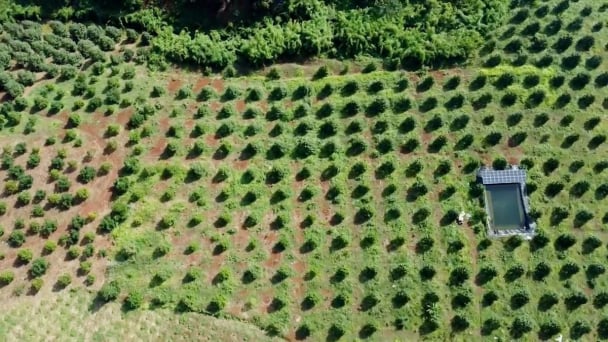June 2, 2025 | 17:01 GMT +7
June 2, 2025 | 17:01 GMT +7
Hotline: 0913.378.918
June 2, 2025 | 17:01 GMT +7
Hotline: 0913.378.918

Why is there such a competition to buy durian in the Central Highlands?
Currently, the Chinese market’s demand for durian products is significant. Meanwhile, the largest durian-growing region in the East of Thailand has ended its harvest season (similar to the durian-growing regions in our country’s Eastern and Southwestern provinces). Although the source of durian from the South of Thailand is still available, the quantity and quality are not outstanding. Therefore, this is when durian in the Central Highlands has the opportunity to dominate the market with abundant supply and generally good quality.
In Vietnam, after China allowed the official export of durian, the value of this industry increased rapidly, leading to the participation of many new agencies, in addition to those specializing in growing durians and pre-existing professional agricultural product consumption.
Market demand is high, the number of people participating in trade is increasing, and the supply is mainly from small-scale gardeners. This is why the competition to buy durian from exporters and traders emerges.
It can be said that almost all durian exporters know that to be able to export effectively, they need to meet customer needs in both quantity and quality. Once a product reaches the market with quality problems, the exporter will undoubtedly have money deducted from the customer, forced to compensate for the contract, or even boycotted. So why do poor quality durians (immature, mushy, rotten...) in foreign markets still occur?
The Central Highlands has a great advantage in the market because the harvest season here differs from Eastern Thailand and the Eastern and Southwestern provinces of Vietnam. In terms of quality, growers in the Central Highlands believe that their durian fruit tastes better than durian in other growing regions thanks to the combination of cultivation on red basalt soil and the highland climate.
However, the Central Highlands has a significant disadvantage in terms of weather. Normally, exporters have the principle of not purchasing goods immediately after prolonged rains. The problem is that this season in the Central Highlands is unpredictable. If we wait until the sunny days to harvest, the durians in the garden are at risk of ripening and cannot be exported.
So is it... the weather’s faults?
In the unique weather conditions of the Central Highlands, there are many experienced garden owners who know how to apply nutrition and are willing to cooperate with buyers to only harvest during favorable weather times, thereby creating high-quality durians for consumers.
On the contrary, if the garden owner does not know how to fertilize properly and wants to promote rapid fruit growth, they are likely to damage the fruits. Worse, when falling under such circumstances, some garden owners also deliberately force the contracted purchasers to accept unripe fruits or not receive the deposit.
Besides, most garden owners want to harvest early to both earn income and avoid falling fruit, and at the same time to restore the garden and prepare for the next crop quickly. This situation is the direct cause of durian not ripening. The fruit’s pulp is not colorful and flavorful when it goes to market.
Traders play an indispensable role in the current agricultural product supply chain of the Central Highlands (and Vietnam), as most gardens are small-scale, remote, and difficult to access.
Unfortunately, it is not uncommon for traders to intentionally make mistakes for personal interests in an industry as full of temptation and fluctuating prices as durian. Specifically, many traders have helped irresponsible gardeners harvest early or on rainy days, regardless of product quality. In many cases, traders are even willing to delay the purchase of durians that, possibly due to pressure from gardeners who previously signed contracts.
Usually, exporters will control the durians’ quality at their unit by recruiting a group of workers who specialize in tapping the fruit to determine its age.
For a long time, professional agricultural export companies have formed several capable, dedicated, and loyal groups of traders and customers to help them select, classify and package exported products.
Meanwhile, new forces entering the industry often recruit tappers from other packaging facilities, in which not everyone is capable and honest with their new employer. In many cases, for personal gain, this group of knockers will deliberately choose damaged or immature fruits to classify them as export standards.
Where there are challenges, there are opportunities. The key, in this case, is the network. Specifically, Vietnam must build a sustainable network between businesses with large growing areas and hundreds of thousands of small-scale farming households. Through that network, large businesses will be the locomotives to motivate small farmers towards a common point called quality and market orientation.
Once the Vietnamese durian industry forms such effective networks, we will not only solve the problem of quality and consumer markets for hundreds of thousands of hectares of durian from small farmers but also help Vietnam’s durian industry have enough quality and quantity to compete with other durian growing countries in Southeast Asia. That is also the fundamental solution that gives the Vietnamese durian industry the opportunity to get ahead in the game.
Translated by Quynh Chi

(VAN) Novel process harnesses machine learning to reveal groups of genes that determine how efficiently plants use nitrogen.

(VAN) Several scientists and farmers are experimenting with soil treatment in some key durian-growing regions such as Cai Lay (Tien Giang), Dak Song, Gia Nghia, and Dak R’lap (Dak Nong).
/2025/05/25/4127-3-073637_820.jpg)
(VAN) Thanks to the promotion from an FAO-implemented project, vegetable production in greenhouses in Moc Chau has seen strong development, from 1.5 hectares in 2021 to nearly 50 hectares in 2024.

(VAN) FAO has recently supported USD 140,000 to implement the project 'Risk mitigation human-animal interface risks through disease control initiatives in pig farming.'

(VAN) The People's Committee of Tra Vinh province has approved an adjustment to the investment policy for the Green Hydrogen Plant project, increasing its area to approximately 52.76 hectares.
![Reducing emissions from rice fields: [2] Farmers’ commitment to the soil](https://t.ex-cdn.com/nongnghiepmoitruong.vn/608w/files/news/2025/05/05/dsc08881jpg-nongnghiep-140632.jpg)
(VAN) Clean rice cultivation model in Thuong Tan commune, Bac Tan Uyen district, is assisting local residents in achieving sustainable agriculture by substantially reducing costs, increasing productivity, and protecting the environment.

(VAN) At the conference to disseminate Resolution No. 68, AgriS introduced its digital agricultural ecosystem and reaffirmed its commitment to accompanying the Government in promoting private sector development and sustainable agriculture.